


xxxxxIn Britain, the years
following the Napoleonic Wars were deeply troubled by social and
political unrest, a situation made the more dangerous in 1830 with
the revolution in France and the overthrow of Charles X. In 1831 the
Whigs put forward a reform bill to increase the franchise and
provide a more equitable distribution of parliamentary seats. After
a struggle it was passed by the Commons, but then rejected by the
House of Lords. This caused violent disturbances in many parts of
the country, and held out the possibility of an all-out
revolution. Fearing such an outcome, William IV agreed to elect a
number of peers to outvote the Tory opposition. Faced with this
threat, the Tories capitulated and the Reform Bill of 1832 became an Act. By it,
members of the upper middle-class gained the right to vote, and
the seats in the Commons were more fairly distributed. It proved the
first step in the right direction, and further reform acts followed
in 1867 and 1884. Two social reforms were also made in the early
1830s. The Factory Act of 1833 limited the hours a child could work,
and the Poor Law of 1834 introduced the idea of the workhouse, a
means by which the destitute could be given food and shelter while
working for their keep.
THE FIRST REFORM ACT 1832 (W4)
Acknowledgements
Election: by
the English painter and social critic William Hogarth (1697-1764,
1755 – Sir John Soane’s Museum, London. Miners:
from the first report of the Children’s Employment Commission,
Mines, 1842, artist unknown. Shaftesbury:
by the English painter George Frederick Watts (1817-1904) –
National Portrait Gallery, London. Wellington:
by the English portrait painter Robert Home (1752-1834), 1804
– National Portrait Gallery, London. Walmer Castle:
from England’s Topographer or A new and
Complete History of the County of Kent by
the English writer William Henry Ireland (1777-1835), 1828,
artist unknown. Duel: by the cartoonist
Thomas Howell Jones, 1829 – King’s College, London.
xxxxxBritain
emerged victorious from the Napoleonic Wars,
but the years after this military triumph were deeply troubled by
social and political unrest. There was widespread unemployment,
extreme hardship and exploitation within the ever-growing
factory system, and a smouldering resentment at the lack of
representation - be it by the middle classes at the outdated
political set-up, or by the working classes at the conditions
being endured in the work place. Some aspects of this discontent had
been shown earlier in the so-called Peterloo Massacre of 1819.
Liberalism had then been silenced, but by the early 1830s, popular
uprisings on the continent, notably in Poland, Germany and France
(where Charles X was overthrown), rekindled the demand for both
political and social reform.
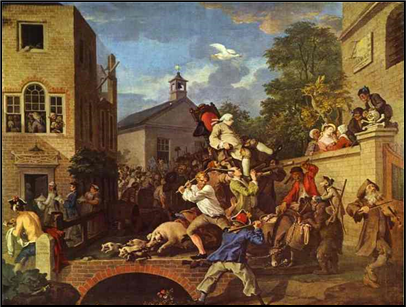 xxxxxSuch was the clamour nation-wide that, in the House
of Commons the Tories, led by the hard-liner the Duke of
Wellington, were forced to make way for a Whig ministry committed to
parliamentary reform. It was long overdue. The distribution of
parliamentary constituencies had not been changed for decades. Rural
areas - much depopulated over the years - had the bulk of
parliamentary seats, whilst the new industrial towns like
Manchester, Birmingham and Leeds - teeming with people -
had none at all. Furthermore the abuses of a political system which
was firmly in the hands of the landed gentry, continued unabated.
There were over fifty “pocket” or “rotten” boroughs which could be
readily obtained at a price, or simply passed on to a relative or
friend. The borough of Old Sarum, for example, which sent two
representatives to the Commons, was a wasteland, the former site of
the city of Salisbury in Wiltshire. Nor were elections run on the
fairest of lines. There was plenty of bribery, corruption and
mayhem, as captured in William Hogarth’s “Election” series of the
1750s. (“Chairing the Member” illustrated
above).
xxxxxSuch was the clamour nation-wide that, in the House
of Commons the Tories, led by the hard-liner the Duke of
Wellington, were forced to make way for a Whig ministry committed to
parliamentary reform. It was long overdue. The distribution of
parliamentary constituencies had not been changed for decades. Rural
areas - much depopulated over the years - had the bulk of
parliamentary seats, whilst the new industrial towns like
Manchester, Birmingham and Leeds - teeming with people -
had none at all. Furthermore the abuses of a political system which
was firmly in the hands of the landed gentry, continued unabated.
There were over fifty “pocket” or “rotten” boroughs which could be
readily obtained at a price, or simply passed on to a relative or
friend. The borough of Old Sarum, for example, which sent two
representatives to the Commons, was a wasteland, the former site of
the city of Salisbury in Wiltshire. Nor were elections run on the
fairest of lines. There was plenty of bribery, corruption and
mayhem, as captured in William Hogarth’s “Election” series of the
1750s. (“Chairing the Member” illustrated
above).
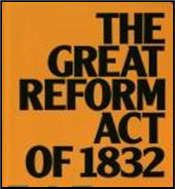 xxxxxThe first reform bill was introduced in 1831. It was
strenuously opposed by the Tories, and it took the dissolving of
Parliament and an election of a new one before a majority could be
secured. This achieved, the bill was then rejected by the House of
Lords. This was the signal for disturbances across the country.
There were fierce riots in London, Birmingham, Nottingham, Derby and
Bristol, and the military had to be called in to stop the sacking
and burning of buildings. The king, fearing a nation-wide
rebellion, reluctantly agreed to create new peers to out-vote
the Tory majority. However, such a move proved unnecessary, and the
possibility of a July Revolution (as in France two years earlier)
was averted. When the bill came before the Lords a second time in
the spring of 1832 about one hundred
peers stayed away - led by the Duke of Wellington - and
the bill became an Act.
xxxxxThe first reform bill was introduced in 1831. It was
strenuously opposed by the Tories, and it took the dissolving of
Parliament and an election of a new one before a majority could be
secured. This achieved, the bill was then rejected by the House of
Lords. This was the signal for disturbances across the country.
There were fierce riots in London, Birmingham, Nottingham, Derby and
Bristol, and the military had to be called in to stop the sacking
and burning of buildings. The king, fearing a nation-wide
rebellion, reluctantly agreed to create new peers to out-vote
the Tory majority. However, such a move proved unnecessary, and the
possibility of a July Revolution (as in France two years earlier)
was averted. When the bill came before the Lords a second time in
the spring of 1832 about one hundred
peers stayed away - led by the Duke of Wellington - and
the bill became an Act.
xxxxxThe
reform measures which were introduced were nothing short of
“sweeping” in the context of the time. The pocket and rotten
boroughs were abolished, parliamentary seats were redistributed on a
much more representative basis, and the franchise was extended,
based on quite a liberal property qualification. As a result the
upper-middle classes gained the vote for the first time, and
the total number of voters was increased from around 440,000 to
657,000. Vast sections of the population, of course, remained
without a vote, and landed interest remained dominant in the new
House of Commons, but it was a start. As we shall see, a further
extension of the franchise, the Second Reform Act, was made in 1867
(Vb) - due
in large measure to the Chartist Movement - and then in 1884
(Vc) voting rights were again extended (the Third Reform Act),
together with another redistribution of parliamentary seats. By
then, aristocratic privilege had come to an end.
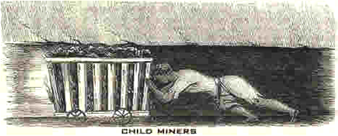 xxxxxOtherxreforms followed in an
attempt to tackle some of the worst social evils of the day. The Factory Act of 1833 was
directed at the appalling abuse of child labour. In many factories
children of seven were put to work for twelve or more hours a day.
The law prohibited the employment of children under the age of nine
and, until they reached thirteen, limited their working week to 48
hours. Some schooling was also provided during the day, the first
step on the long road to compulsory, universal education. Thexfollowing year changes were also made in the poor laws.
The Poor Law of 1834
saw the introduction of the workhouse, an institution which, despite
all its faults, attempted to give the unemployed food and shelter
whilst working for their keep.
xxxxxOtherxreforms followed in an
attempt to tackle some of the worst social evils of the day. The Factory Act of 1833 was
directed at the appalling abuse of child labour. In many factories
children of seven were put to work for twelve or more hours a day.
The law prohibited the employment of children under the age of nine
and, until they reached thirteen, limited their working week to 48
hours. Some schooling was also provided during the day, the first
step on the long road to compulsory, universal education. Thexfollowing year changes were also made in the poor laws.
The Poor Law of 1834
saw the introduction of the workhouse, an institution which, despite
all its faults, attempted to give the unemployed food and shelter
whilst working for their keep.
xxxxxIncidentally, it was at this time (as noted earlier) that the
politician Sir Robert Peel, in order to shed the Tories of their
reactionary image and thus widen their membership, defined the aims
of the party in his Tamworth Address of 1834. This advocated measures of reform within
existing institutions, stressed the importance of law and order, and
promised continued support to trade, industry and the landed
interests. This address is often seen as the launch of the modern
Conservative Party, a term first used by the writer and arch Tory
John Wilson Croker in the Quarterly Review
of January 1830. The Whigs adopted the title of the Liberal Party in
the late 1830s, though the first Liberal government in the modern
sense was not formed until 1868. ……
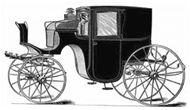 xxxxx…… Axstout
supporter of the Reform Bill was the Whig politician Henry
(later Baron) Brougham (1778-1868), a
man of fashion who was known for his wit and somewhat eccentric
behaviour. He helped to found the Edinburgh
Review in 1802, played a leading part in the foundation of
London University, and was Lord Chancellor form 1830-34. He
supported a number of other good causes, including education and law
reform, but he is best remembered today for his design of “The
Brougham”, originally a four-wheeled carriage drawn by one
horse. He spent most of his last thirty years in Cannes, on the
French Riviera, and it was there that he died in 1868.
xxxxx…… Axstout
supporter of the Reform Bill was the Whig politician Henry
(later Baron) Brougham (1778-1868), a
man of fashion who was known for his wit and somewhat eccentric
behaviour. He helped to found the Edinburgh
Review in 1802, played a leading part in the foundation of
London University, and was Lord Chancellor form 1830-34. He
supported a number of other good causes, including education and law
reform, but he is best remembered today for his design of “The
Brougham”, originally a four-wheeled carriage drawn by one
horse. He spent most of his last thirty years in Cannes, on the
French Riviera, and it was there that he died in 1868.
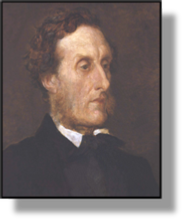 xxxxxAnother Englishman of this
period who played a prominent part in supporting and guiding major
social reforms through parliament was the statesman and
philanthropist Anthony Ashey Cooper, the 7th Earl
of Shaftesbury (1801-1885). He served
in the House of Commons for twenty five years before he succeeded to
the earldom and took his seat in the Lords. Ironically enough, he
was not in favour of the Reform Bill, being against the widening of
the franchise, but he did much to improve working conditions in
factories, especially for women and children, and as a member of the
Ragged School Union he was instrumental in providing free education
for the poor. He also supported the Mines Act of 1842, which put an
end to women and children working underground, and the Lunacy Act of
1845, aimed at improving asylums for “persons of unsound mind”.
xxxxxAnother Englishman of this
period who played a prominent part in supporting and guiding major
social reforms through parliament was the statesman and
philanthropist Anthony Ashey Cooper, the 7th Earl
of Shaftesbury (1801-1885). He served
in the House of Commons for twenty five years before he succeeded to
the earldom and took his seat in the Lords. Ironically enough, he
was not in favour of the Reform Bill, being against the widening of
the franchise, but he did much to improve working conditions in
factories, especially for women and children, and as a member of the
Ragged School Union he was instrumental in providing free education
for the poor. He also supported the Mines Act of 1842, which put an
end to women and children working underground, and the Lunacy Act of
1845, aimed at improving asylums for “persons of unsound mind”.
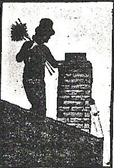
xxxxxToday, Shaftesbury is
especially remembered for persuading Parliament in 1846 to forbid
the use of young children being used as chimney sweeps. Among those
he assisted financially were Florence Nightingale in her work to
improve hospital nursing, and Thomas Barnardo in his provision of
homes for destitute children. He was leader of the evangelical
movement within the Church of England and favoured the political  emancipation
of Roman Catholics.
emancipation
of Roman Catholics.
xxxxxIncidentally, in 1893 a memorial was erected in Piccadilly Circus,
London, to commemorate Lord
Shaftesbury’s work for good causes. It was crowned by a nude figure
of Anteros, a butterfly-winged
archer depicting the Greek God of unrequited love. However, the
figure was mistaken for Eros, the God of
love, and the monument became known by that name! Today it is a
London landmark. ……
xxxxx……
Thexwork of the Ragged School Union, which
Shaftsbury helped to found in 1844, was actually started some forty
years earlier by John Pounds (1766-1839). Born in Portsmouth, he became a
shipwright apprentice at the age of 12, but three years later he was
badly injured at work and became a cripple for life. He took up shoe
making and around 1802, while working at his shop in Portsmouth, he
began to give free schooling to local poor children. The idea was
taken up by others and the scheme eventually came to the notice of
Shaftsbury. He put it on a firm footing.
Including:
The Earl of Shaftesbury
and The Duke of
Wellington

W4-1830-1837-W4-1830-1837-W4-1830-1837-W4-1830-1837-W4-1830-1837-W4-1830-1837-W4
xxxxxIn contrast to Lord
Shaftsbury, a politician who lost a great deal of public support
because of his opposition to political and social reform was the Duke of Wellington. As we have
seen, on becoming Tory prime minister in 1828 he had antagonised his
party by making a U-turn and pushing through the Catholic
Emancipation Act of 1829, a decision he thought necessary to avoid a
civil war in Ireland. The following year, however, he lost the
support of the majority of the country’s population by coming out
strongly against any reform measures. This uncompromising stand
brought about the downfall of his government and made him a target
of abuse. As we have seen (1815 G3c), on returning to England after the Battle of Waterloo
Wellington was drawn into politics. He served as a Tory until
resigning in 1827, and the following year was made prime minister at
the insistence of William IV. It was then that he ran into trouble
with his own party over the question of Catholic Emancipation, and
then angered the public by his anti-reform policy. Later, in
the early 1840s, he assisted Sir John Peel in abolishing the Corn
Laws - against his own judgement once again - but retired
from public life in 1846. He held many public offices during his
long career, and was advisor to the young Queen Victoria. As a
soldier, he lacked the common touch, but he was an outstanding
commander, albeit somewhat cautious at times. As a politician he was
reactionary by nature, but it is to his credit that he was prepared,
when necessary, to put aside his own views in the interest of his
nation’s welfare. Few men have served their country better.
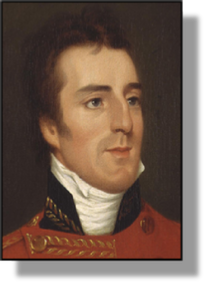 xxxxxBy contrast, one politician at this time who lost a
great deal of public support because of his fervent opposition to
any political or social reform was the Duke
of Wellington. As we have seen, as Tory
prime minister he had angered many of his party in 1829 by doing a
U-turn and pushing through the Catholic Emancipation Act
(giving civil and political rights to Roman Catholics). He had then
gone along with his home secretary, Sir John Peel, to avoid a
possible civil war in Ireland, but his action was seen by hard-liners
as a betrayal of Tory principles. In 1830, however, he pleased his
party but alienated the general public by speaking out against any
reform measures whatsoever. He argued, in particular, that there was
nothing wrong with the present electoral system, and any changes to
it would ruin the country. This uncompromising stand not only
brought about the prompt downfall of his weak and unpopular
government, but also made him a target for abuse. The windows of
Apsley House, his residence near Hyde Park Corner, were smashed by
violent mobs on more than one occasion, and he was obliged to put up
iron shutters to stop further damage. It was that action, not his
glorious career on the battlefield, which earned him the title of
“the Iron Duke”!
xxxxxBy contrast, one politician at this time who lost a
great deal of public support because of his fervent opposition to
any political or social reform was the Duke
of Wellington. As we have seen, as Tory
prime minister he had angered many of his party in 1829 by doing a
U-turn and pushing through the Catholic Emancipation Act
(giving civil and political rights to Roman Catholics). He had then
gone along with his home secretary, Sir John Peel, to avoid a
possible civil war in Ireland, but his action was seen by hard-liners
as a betrayal of Tory principles. In 1830, however, he pleased his
party but alienated the general public by speaking out against any
reform measures whatsoever. He argued, in particular, that there was
nothing wrong with the present electoral system, and any changes to
it would ruin the country. This uncompromising stand not only
brought about the prompt downfall of his weak and unpopular
government, but also made him a target for abuse. The windows of
Apsley House, his residence near Hyde Park Corner, were smashed by
violent mobs on more than one occasion, and he was obliged to put up
iron shutters to stop further damage. It was that action, not his
glorious career on the battlefield, which earned him the title of
“the Iron Duke”!
xxxxxAs we have seen (1815 G3c), after his career
in the army, Wellington returned to England in 1818 and was drawn
into the political arena. A straightforward and honest man, he was
not always at home in this new “battlefield”. He served in the Tory
government of Lord Liverpool, attending the Congress of Verona in
1822, but resigned in 1827 (taking half the cabinet with him!) when
George Canning - who favoured Catholic Emancipation -
became prime minister. The following year, however, on the
insistence of William IV, he formed his own government, and it was
then, over the next two years, that he became unpopular with his
party, first over his support of Catholic Emancipation, and then
with the population at large over his reactionary stand against any
measure of reform, political or social.
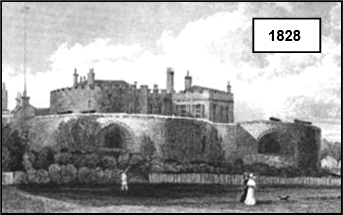
xxxxxDuring the mid-1830s
he served as foreign secretary under Peel and then, as minister
without portfolio, assisted him in abolishing the Corn Laws, acting
against his own judgement once again. He retired from public life in
1846. Among the offices he held during his political career were
commander in chief of the forces - an appointment made
permanent in 1842 -, chancellor of the University of Oxford,
constable of the Tower, and master of Trinity House. He was an
advisor and father figure to the young Queen Victoria, and, as Lord
Warden of the Cinque Ports, he was living at Walmer Castle in Kent (illustrated) when he died of a
stroke in 1852. He was given a monumental state funeral - one
befitting the “Great Duke” - and was buried in St. Paul’s
Cathedral.
xxxxxAs a soldier, Wellington
was an outstanding general, though he lacked the common touch and is
viewed by some as a rather over-cautious commander. As a
politician he was certainly reactionary, but, when necessary, he was
prepared to compromise his own views in the interests of his
country, and he was honest and upright in all his dealings. He was,
indeed, a public servant without rival during a long and
distinguished career.
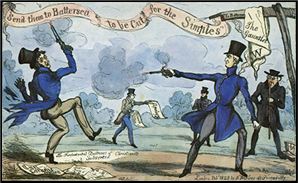 xxxxxIncidentally, having
eventually persuaded his party and the king to accept Catholic
Emancipation in 1829 - his greatest political triumph -
Wellington was criticised by a number of die-hard Tories. By
all accounts, one of them, the Earl of Winchelsea, went so far as to
insult the Duke and was challenged to a duel. The contest took place
at Battersea Fields but, having made their point, both men chose to
shoot wide deliberately! ……
xxxxxIncidentally, having
eventually persuaded his party and the king to accept Catholic
Emancipation in 1829 - his greatest political triumph -
Wellington was criticised by a number of die-hard Tories. By
all accounts, one of them, the Earl of Winchelsea, went so far as to
insult the Duke and was challenged to a duel. The contest took place
at Battersea Fields but, having made their point, both men chose to
shoot wide deliberately! ……
xxxxx……
In 1817 a grateful nation presented Wellington with the stately home
and estate of Stratfield Saye in the county of Hampshire, and it has
remained the home of the Dukes of Wellington ever since. The Duke’s
London home was Apsley House at Hyde Park Corner, and this now
serves as a museum and an art gallery, run by English Heritage.






 xxxxxSuch was the clamour nation-
xxxxxSuch was the clamour nation- xxxxxThe first reform bill was introduced in 1831. It was
strenuously opposed by the Tories, and it took the dissolving of
Parliament and an election of a new one before a majority could be
secured. This achieved, the bill was then rejected by the House of
Lords. This was the signal for disturbances across the country.
There were fierce riots in London, Birmingham, Nottingham, Derby and
Bristol, and the military had to be called in to stop the sacking
and burning of buildings. The king, fearing a nation-
xxxxxThe first reform bill was introduced in 1831. It was
strenuously opposed by the Tories, and it took the dissolving of
Parliament and an election of a new one before a majority could be
secured. This achieved, the bill was then rejected by the House of
Lords. This was the signal for disturbances across the country.
There were fierce riots in London, Birmingham, Nottingham, Derby and
Bristol, and the military had to be called in to stop the sacking
and burning of buildings. The king, fearing a nation- xxxxxOtherxreforms followed in an
attempt to tackle some of the worst social evils of the day. The Factory Act of 1833 was
directed at the appalling abuse of child labour. In many factories
children of seven were put to work for twelve or more hours a day.
The law prohibited the employment of children under the age of nine
and, until they reached thirteen, limited their working week to 48
hours. Some schooling was also provided during the day, the first
step on the long road to compulsory, universal education. Thexfollowing year changes were also made in the poor laws.
The Poor Law of 1834
saw the introduction of the workhouse, an institution which, despite
all its faults, attempted to give the unemployed food and shelter
whilst working for their keep.
xxxxxOtherxreforms followed in an
attempt to tackle some of the worst social evils of the day. The Factory Act of 1833 was
directed at the appalling abuse of child labour. In many factories
children of seven were put to work for twelve or more hours a day.
The law prohibited the employment of children under the age of nine
and, until they reached thirteen, limited their working week to 48
hours. Some schooling was also provided during the day, the first
step on the long road to compulsory, universal education. Thexfollowing year changes were also made in the poor laws.
The Poor Law of 1834
saw the introduction of the workhouse, an institution which, despite
all its faults, attempted to give the unemployed food and shelter
whilst working for their keep.  xxxxx…… Axstout
supporter of the Reform Bill was the Whig politician Henry
(later Baron) Brougham (1778-
xxxxx…… Axstout
supporter of the Reform Bill was the Whig politician Henry
(later Baron) Brougham (1778- xxxxxAnother Englishman of this
period who played a prominent part in supporting and guiding major
social reforms through parliament was the statesman and
philanthropist Anthony Ashey Cooper, the 7th Earl
of Shaftesbury (1801-
xxxxxAnother Englishman of this
period who played a prominent part in supporting and guiding major
social reforms through parliament was the statesman and
philanthropist Anthony Ashey Cooper, the 7th Earl
of Shaftesbury (1801-
 emancipation
of Roman Catholics.
emancipation
of Roman Catholics.
 xxxxxBy contrast, one politician at this time who lost a
great deal of public support because of his fervent opposition to
any political or social reform was the Duke
of Wellington. As we have seen, as Tory
prime minister he had angered many of his party in 1829 by doing a
U-
xxxxxBy contrast, one politician at this time who lost a
great deal of public support because of his fervent opposition to
any political or social reform was the Duke
of Wellington. As we have seen, as Tory
prime minister he had angered many of his party in 1829 by doing a
U-
 xxxxxIncidentally, having
eventually persuaded his party and the king to accept Catholic
Emancipation in 1829 -
xxxxxIncidentally, having
eventually persuaded his party and the king to accept Catholic
Emancipation in 1829 -

